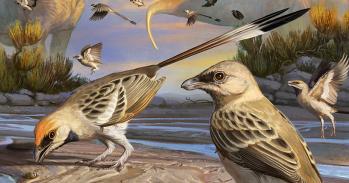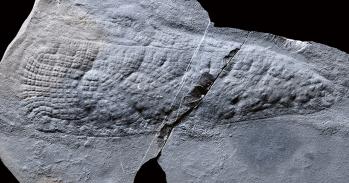
A newly-discovered genus of shark that prowled Earth’s oceans 100 million years ago - and is thought to have been the ancestor of the great white - has been named after the Director of Cambridge University’s Sedgwick Museum of Earth Sciences, Ken McNamara.
A newly-discovered genus of shark that prowled Earth’s oceans 100 million years ago - and is thought to have been the ancestor of the great white - has been named after the Director of Cambridge University’s Sedgwick Museum of Earth Sciences, Ken McNamara.
It is quite cool to have a fossil shark named after me.
Ken McNamara
The new genus Kenolamna has been revealed through the study of fossilised shark teeth which date back 100-80 million years ago.
The finds, which have revolutionised the early history of megatooth sharks, were named in honour of McNamara after his 30 years as palaeontology curator of the Western Australian Museum.
The fossil material, from Western Australia, indicates the otodontid sharks were one of the most diverse and successful groups of sharks during the later stages of the Cretaceous period, 100-65 million years ago; unravelling previous assumptions that they were only ever represented by one species of shark at any given time.
Dr McNamara, who has been Director of the Sedgwick Museum for two years, said he was ‘thrilled’ that the genus would boast his name.
“A load of ancient fossils have been named after me…is that a compliment? In this case I’ll say yes. But in all seriousness, it is quite cool to have a fossil shark named after me, especially as it is thought to have been the ancestor of the great white shark.
“This is quite a major shift in our understanding; an awful lot of work has been done to work out how our modern sharks have evolved. This extinct group of predators is also thought to have been an ancestor of the Otodus megalodon or Carcharocles megalodon – a 20 metre-long monster of the deep.” Kenolamna was about 3 metres long.
Current Western Australian Museum Curator of Palaeontology Dr Mikael Siversson led the international team of researchers from Australia, Canada and Sweden and said the findings have rewritten the history books.
He said: After collecting new fossil material and examining existing collections, we were surprised to find otodontid sharks were in fact one of the most diverse and successful groups of sharks during the later stages of the Cretaceous period.”
Dr McNamara said that having the genus named after him by peers in the scientific community is better than being awarded a knighthood.
However, this is not the first time he has had a genus named after him. A now extinct class of armoured prehistoric fish, formally described in 1995, was given the name Mcnamaraspis kaprios. The genus name Mcnamaraspis was given in honour of Dr McNamara. Later that year, Mcnamaraspis kaprios was selected as the State Fossil Emblem for Western Australia.
Although Dr McNamara tries to keep his own research interests alive (these include using fossils, particularly trilobites and sea urchins, to understand the relationship between developmental change and evolution; studying evidence from trace fossils for the colonisation of land; and trying to unravel how fossils were viewed by our prehistoric ancestors) the demands of running a University museum, teaching and acting as the Dean of Downing College limit the time he has to undertake his own work in these areas.
“Being Director of this place is fantastic,” he added. “The Sedgwick Museum’s collections, in paleontological terms, are the best in the world. Every time, I come down to the museum I’m like a kid in a sweet shop. We have researchers from all over the world coming to use and study our collections – collections so significant that they record first-hand the dawn of geology as a science, as well as exhibits that can take us back to the beginnings of the solar system itself.”
However, for all the Sedgwick’s astonishing collections (only a tiny percentage of which can be displayed at any one time), it does not yet have a fossil example of the type named after its director - although Dr McNamara has requested some samples from Dr Mikael Siversson and his team.
This work is licensed under a Creative Commons Licence. If you use this content on your site please link back to this page.





